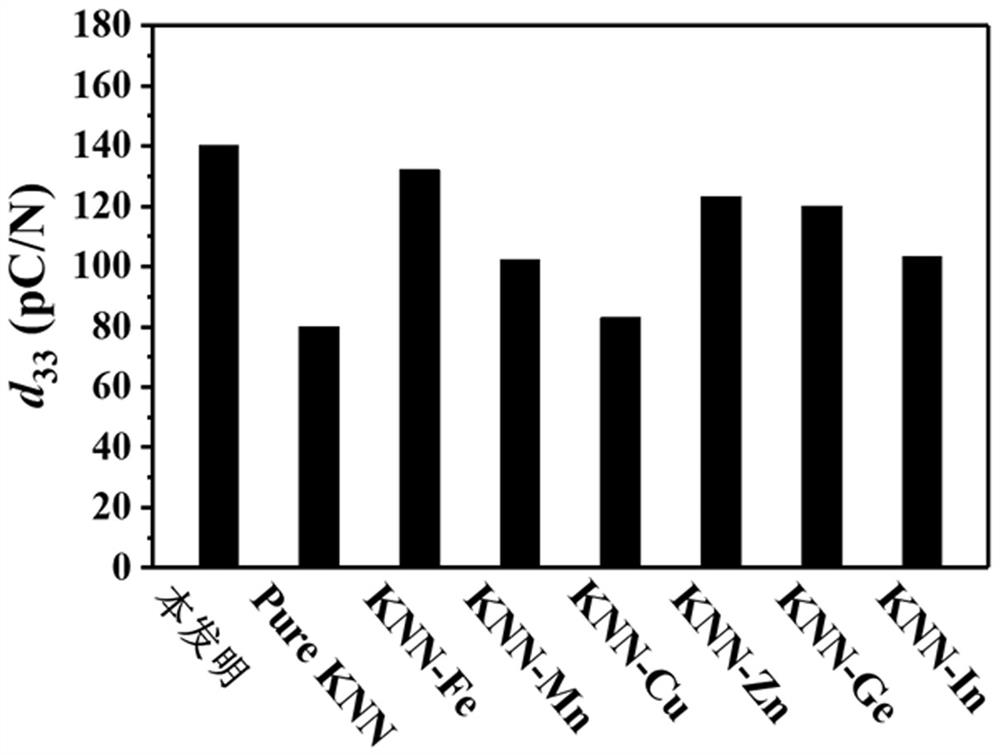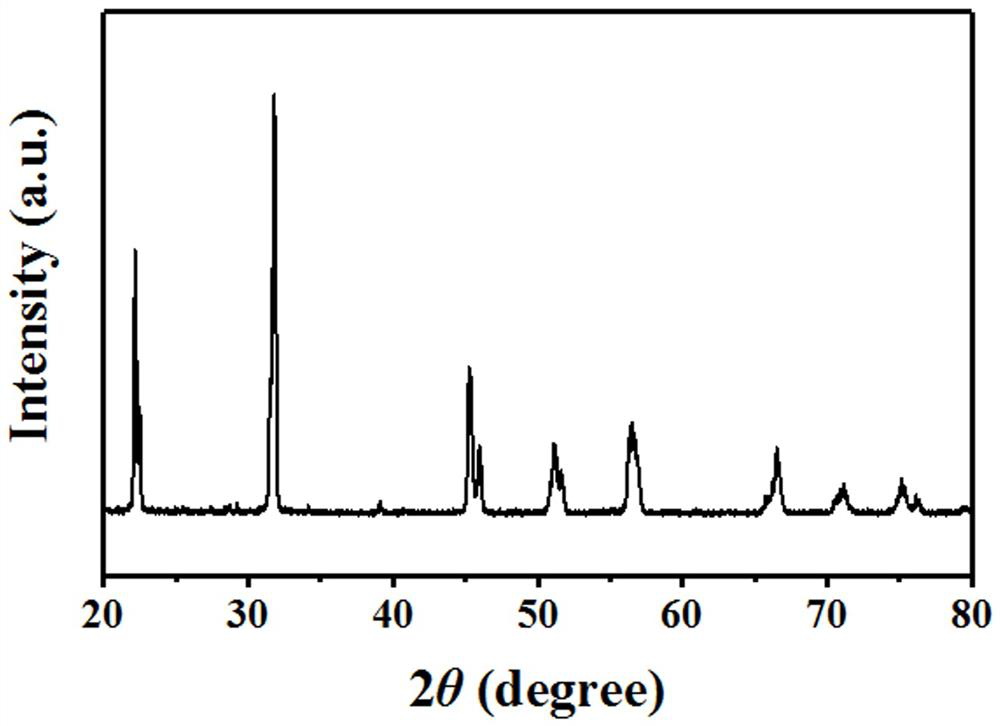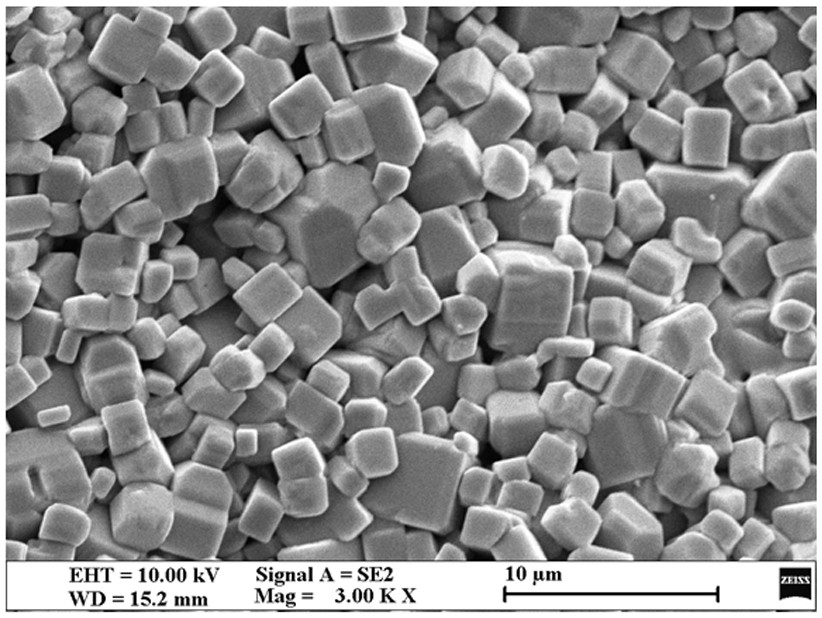Method for promoting cold sintering of potassium-sodium niobate-based leadless piezoelectric ceramics
A potassium-sodium niobate-based, lead-free piezoelectric technology, applied in the field of functional ceramic materials, can solve problems such as uneven distribution of water-based liquid phases, achieve the effects of shortening the preparation cycle, simplifying the process flow, and uniform distribution
- Summary
- Abstract
- Description
- Claims
- Application Information
AI Technical Summary
Problems solved by technology
Method used
Image
Examples
Embodiment 1
[0036] (1) Ingredients: K 2 CO 3 、Na 2 CO 3 and Nb 2 o 5 Mix according to molar ratio 1:1:2 to obtain compound;
[0037] (2) Ball milling: put the mixture into the ball milling tank, then add the ball milling medium into the ball milling tank, and fully mill it for 12 hours. After the ball milling, transfer the mixed slurry to a crystallization dish and place it in an oven at 80°C Dry in the oven, and then put the mixture into the mortar for grinding;
[0038] (3) Pre-burning: Add the above-mentioned ground mixture into the crucible, compact and cover it, put it in the muffle furnace, heat it up to 850°C for 4 hours, and take it out after it is naturally cooled to room temperature;
[0039](4) Secondary ball milling: Add the above-mentioned pre-calcined mixture into the ball milling tank, and add the ball milling medium into the ball milling tank, and fully mill it for 12 hours. After the ball milling, transfer the slurry to the crystallization dish and place Dry in an ...
Embodiment 2
[0046] (1) Ingredients: K 2 CO 3 、Na 2 CO 3 and Nb 2 O 5 Mix according to molar ratio 1:1:2 to obtain compound;
[0047] (2) Ball milling: put the mixture into the ball milling tank, then add the ball milling medium into the ball milling tank, and fully mill it for 12 hours. After the ball milling, transfer the mixed slurry to a crystallization dish and place it in an oven at 80°C Dry in the oven, and then put the mixture into the mortar for grinding;
[0048] (3) Pre-burning: Add the above-mentioned ground mixture into the crucible, compact and cover it, put it in the muffle furnace, heat it up to 850°C for 4 hours, and take it out after it is naturally cooled to room temperature;
[0049] (4) Secondary ball milling: Add the above-mentioned pre-calcined mixture into the ball milling tank, and add the ball milling medium into the ball milling tank, and fully mill it for 12 hours. After the ball milling, transfer the slurry to the crystallization dish and place Dry in an...
Embodiment 3
[0059] (1) Ingredients: K 2 CO 3 、Na 2 CO 3 and Nb 2 O 5 According to the molar ratio of 1:1:2 mixed to obtain a mixture
[0060] (2) Ball milling: put the mixture into the ball milling tank, then add the ball milling medium into the ball milling tank, and fully mill it for 12 hours. After the ball milling, transfer the mixed slurry to a crystallization dish and place it in an oven at 80°C Dry in the oven, and then put the mixture into the mortar for grinding;
[0061] (3) Pre-burning: Add the above-mentioned ground mixture into the crucible, compact and cover it, put it in the muffle furnace, heat it up to 850°C for 4 hours, and take it out after it is naturally cooled to room temperature;
[0062] (4) Secondary ball milling: Add the above-mentioned pre-calcined mixture into the ball milling tank, and add the ball milling medium into the ball milling tank, and fully mill it for 12 hours. After the ball milling, transfer the slurry to the crystallization dish and place ...
PUM
| Property | Measurement | Unit |
|---|---|---|
| piezoelectric charge coefficient | aaaaa | aaaaa |
| piezoelectric charge coefficient | aaaaa | aaaaa |
| piezoelectric charge coefficient | aaaaa | aaaaa |
Abstract
Description
Claims
Application Information
 Login to View More
Login to View More - R&D
- Intellectual Property
- Life Sciences
- Materials
- Tech Scout
- Unparalleled Data Quality
- Higher Quality Content
- 60% Fewer Hallucinations
Browse by: Latest US Patents, China's latest patents, Technical Efficacy Thesaurus, Application Domain, Technology Topic, Popular Technical Reports.
© 2025 PatSnap. All rights reserved.Legal|Privacy policy|Modern Slavery Act Transparency Statement|Sitemap|About US| Contact US: help@patsnap.com



